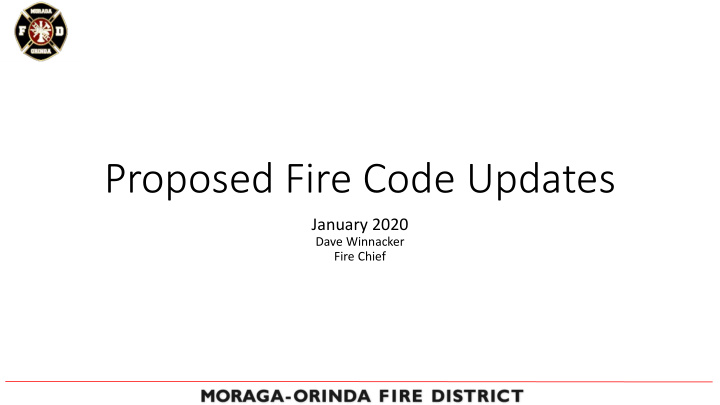



Proposed Fire Code Updates January 2020 Dave Winnacker Fire Chief
Fire History -Within 2 miles of the Caldecott Tunnel, 15 major fires have burned since Hwy 24 1923 -Eleven of these fires destroyed 3,542 homes, took 26 lives, and caused over $2 billion in losses
Fall Diablo Winds
Fire Science 1. Fire is normal for this area • 3-5 year burn cycle pre-European settlers 2. Fire spreads via two components • Flame Front • 3 Dimensional Ember Cast • Embers require a receptive fuel bed to start a spot fire • Spot fires can grow to be large fires 3. Fire Spread Rates and Intensity are a product of • Topography • Weather • Fuel
MOFD Wildfire Prevention Strategic Plan Seven Lines of Effort 1. External fuels mitigation projects 2. Internal fuels mitigation projects 3. Wildfire preplanning 4. Evacuation planning 5. Building code updates 6. Community outreach and education 7. Early detection and notification systems
Code Update Process 1. Community Input 2. Presentation to elected boards and councils • MOFD Board of Directors • City of Orinda Council • Town of Moraga Council • County Board of Supervisors 3. Directed changes 4. First reading 5. Second reading and adoption via ordinance
Wildland Urban Interface Declaration References 1. 2019 California Fire Code cites Health and Safety Code 13143, 13108.5(a) and 1849.2(b) and (c) as the reference for WUI 2. The Health and Safety Code states: “urban wildland interface community” means a community listed in “Communities at Risk from Wild Fires” produced by the California Dept of Forestry and Fire Protection, Fire and Resource Assessment Program, pursuant to the National Fire Plan, federal Fiscal Year 2001 Department of the Interior and Related Agencies Appropriation Act (Public Law 106-291). 3. The Office of the State Fire Marshal publishes a list of Communities at Risk which includes Moraga, Orinda, and Canyon • https://osfm.fire.ca.gov/divisions/wildfire-planning-engineering/fire- plan/communities-at-risk/ Moraga, Orinda, and Canyon have been designated as WUI for years
Existing Parcels and Structures 1. Move annual compliance date from 15 June to 31 May 2. Extend abatement period from 10 to 15 days 3. Ban the use of combustible ground cover (to include Mulch) within 2’ of structures (https://ibhs.org/wildfire/wildfire-demo-2019/ https://www.unce.unr.edu/publications/files/nr/2011/sp1104.pdf) 4. Require at least a 2’ air gap between the ground and vegetation within 2’ of structures 5. Increase the clearance for trees from 5’ to 6’ 6. Require the removal of Eucalyptus and Monterrey Pine within 6’ of structures 7. Require an exterior fire hazard inspection for real property transfers 8. Require the removal of Juniper and Bamboo within 10’ of a road by the end of 2023
Removal of mulch and combustible vegetation within 2’ of a home is intended to make our community like the right side of this example Full videos showing ember caused fire in mulch: https://ibhs.org/wildfire/wildfire-demo-2019/ https://vimeo.com/79340385
Major Remodels and Additions to Existing Structures 1. Decrease the threshold for residential fire sprinklers to 3600 Sq/Ft or an increase exceeding 100% of existing square feet 2. Requires exterior under eave fire sprinklers for residential structures that require new systems
New Structures 1. Declares all areas of the District Wildland Urban Interface for purposes of the fire code 2. Requires ember resistant construction, as defined in Building Code Chapter 7A and Residential Code Chapter 337 3. Bans the use of combustible building material within 3’ of new structures 4. Requires exterior under eave sprinklers for residential systems 5. Increases road width from 16’ to 18’ for 1-2 new units 6. Increases road width to 28’ for 3 or more new units 7. Allows for waiver of remoteness requirement for large development road access with a Fire Protection Plan
Recommend
More recommend